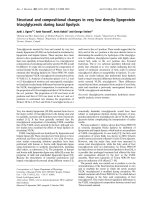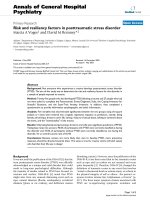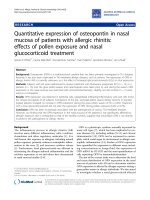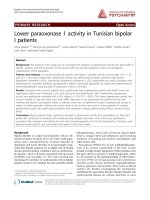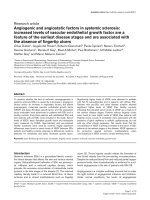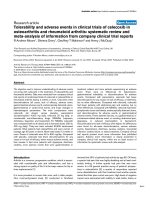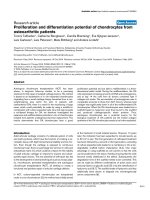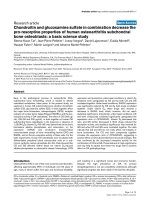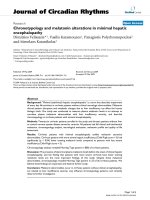Báo cáo y học: "Discomfort and factual recollection in intensive care unit patients" pptx
Bạn đang xem bản rút gọn của tài liệu. Xem và tải ngay bản đầy đủ của tài liệu tại đây (171.95 KB, 7 trang )
Open Access
Available online />R467
December 200 4 Vol 8 No 6
Research
Discomfort and factual recollection in intensive care unit patients
Johannes P van de Leur
1
, Cees P van der Schans
2
, Bert G Loef
3
, Betto G Deelman
4
,
Jan HB Geertzen
5
and Jan H Zwaveling
6
1
Physiotherapist, Center for Rehabilitation, University Hospital Groningen, Groningen, The Netherlands
2
Professor of Nursing Science, University for Professional Education, Hanzehogeschool Groningen, and Department of Health Sciences, University
of Groningen, Groningen, The Netherlands
3
Supervisor, Department of Cardio-Thoracic Surgery, University Hospital Groningen, Groningen, The Netherlands
4
Emeritus Professor of Neuropsychology, Department of Neuropsychology, University Hospital Groningen, Groningen, The Netherlands
5
Professor of Rehabilitation, Center for Rehabilitation, University Hospital Groningen, and Northern Center for Health Care Research, Groningen, The
Netherlands
6
Professor of Surgical Intensive Care, Department General Surgery and Surgical Intensive Care Unit, University Hospital Groningen, Groningen, The
Netherlands
Corresponding author: Johannes P van de Leur,
Abstract
Introduction A stay in the intensive care unit (ICU), although potentially life-saving, may cause considerable discomfort to patients.
However, retrospective assessment of discomfort is difficult because recollection of stressful events may be impaired by sedation
and severe illness during the ICU stay. This study addresses the following questions. What is the incidence of discomfort reported
by patients recently discharged from an ICU? What were the sources of discomfort reported? What was the degree of factual
recollection during patients' stay in the ICU? Finally, was discomfort reported more often in patients with good factual recollection?
Methods All ICU patients older than 18 years who had needed prolonged (>24 hour) admission with tracheal intubation and
mechanical ventilation were consecutively included. Within three days after discharge from the ICU, a structured, in-person interview
was conducted with each individual patient. All patients were asked to complete a questionnaire consisting of 14 questions
specifically concerning the environment of the ICU they had stayed in. Furthermore, they were asked whether they remembered any
discomfort during their stay; if they did then they were asked to specify which sources of discomfort they could recall. A reference
group of surgical ward patients, matched by sex and age to the ICU group, was studied to validate the questionnaire.
Results A total of 125 patients discharged from the ICU were included in this study. Data for 123 ICU patients and 48 surgical ward
patients were analyzed. The prevalence of recollection of any type of discomfort in the ICU patients was 54% (n = 66). These 66
patients were asked to identify the sources of discomfort, and presence of an endotracheal tube, hallucinations and medical activities
were identified as such sources. The median (min–max) score for factual recollection in the ICU patients was 15 (0–28). The median
(min–max) score for factual recollection in the reference group was 25 (19–28). Analysis revealed that discomfort was positively
related to factual recollection (odds ratio 1.1; P < 0.001), especially discomfort caused by the presence of an endotracheal tube,
medical activities and noise. Hallucinations were reported more often with increasing age. Pain as a source of discomfort was
predominantly reported by younger patients.
Conclusion Among postdischarge ICU patients, 54% recalled discomfort. However, memory was often impaired: the median factual
recollection score of ICU patients was significantly lower than that of matched control patients. The presence of an endotracheal
tube, hallucinations and medical activities were most frequently reported as sources of discomfort. Patients with a higher factual
recollection score were at greater risk for remembering the stressful presence of an endotracheal tube, medical activities and noise.
Younger patients were more likely to report pain as a source of discomfort.
Keywords: discomfort, hallucinations, intensive care unit, recollection
Received: 12 July 2004
Revisions requested: 4 August 2004
Revisions received: 7 September 2004
Accepted: 17 September 2004
Published: 28 October 2004
Critical Care 2004, 8:R467-R473 (DOI 10.1186/cc2976)
This article is online at: />© 2004 van de Leur et al., licensee BioMed Central Ltd.
This is an Open Access article distributed under the terms of the
Creative Commons Attribution License ( />licenses/by/2.0), which permits unrestricted use, distribution, and
reproduction in any medium, provided the original work is cited.
APACHE = Acute Physiology and Chronic Health Evaluation; ICU = intensive care unit; OR = odds ratio.
Critical Care December 2004 Vol 8 No 6 van de Leur et al.
R468
Introduction
Being admitted to an intensive care unit (ICU) can be consid-
ered a stressful life event, the reason for admission being a
critical or even life-threatening condition. The ICU stay itself
may also be stressful. Some patients report vivid recollections
[1-3] whereas others have a poor or even no recollection at all
of their stay on the ICU. No recollection at all of the ICU study
ranges from 23% to 38% among postsurgical patients [4].
Various authors have reported that patients had unpleasant
recollections after a stay on an ICU. Patients recalled discom-
fort arising from anxiety, pain, thirst, sleeplessness, disorienta-
tion, shortness of breath, inability to move, painful medical
interventions and the presence of an endotracheal tube [5].
Turner and coworkers [6] specifically mentioned arterial blood
gas sampling and endotracheal suctioning.
However, recollection of discomfort during the ICU stay is
inseparably connected to the quality of recollection itself:
events considered stressful at the time may not be remem-
bered; conversely, recollections of stressful events may not be
based on actual experiences. Jones and coworkers [7] inves-
tigated patients' estimation of the duration of their ICU stay in
order to evaluate the accuracy of their memories. The patients'
recall of events was generally poor, and 41% of them felt that
they had been confused at some time during their stay in the
ICU. To our knowledge, there is no literature investigating
whether the recollection of discomfort is related to the accu-
racy of recollection of facts as such, and for what sources of
discomfort this holds true. The purpose of this study was to
describe the incidence of discomfort reported by ICU patients,
the sources of their discomfort, the factual recollection of ICU
patients and ward patients, and determinants of the recollec-
tion of discomfort in ICU patients.
Methods
Consecutive ICU patients, who were older than 18 years and
who had undergone intubation for longer than 24 hours, were
included in the study. During mechanical ventilation patients
received sedation by continuous infusion of midazolam (range
1–4 mg/hour) and fentanyl (range 50–150 µg/hour), with the
degree of sedation given depending on their clinical require-
ments. The patients participated in a study comparing routine
endotracheal suctioning with minimally invasive airway suc-
tioning. The study was approved by the medical ethics com-
mittee of the University Hospital. The Acute Physiology Age
and Chronic Health Evaluation (APACHE) II score was used
to quantify the severity of illness [8] and was recorded on the
day of admission to the ICU.
All ICU patients participated in a structured in-person inter-
view, using a standardized questionnaire, within three days
after discharge from the ICU to the ward. The reference group
consisted of postsurgical ward patients, matched for age and
sex. Data from the reference group were obtained in a struc-
tured telephone interview conducted within three days after
discharge from hospital. In the questionnaire, all patients were
asked to give answers to 14 questions concerning the ICU
environment (lighting, timing of ward rounds, number of fellow
ICU patients), the nursing staff (uniform, male/female) and per-
sonal care (clothing, position of intravenous drip, washing and
toilet activities).
Patients from the ICU group were asked whether they remem-
bered any discomfort during their stay on the ICU, and if they
did then they were asked to specify the sources of discomfort
that they remembered.
The questions regarding recollection of facts were first asked
as open questions. Two points were given for each correct
answer to these open questions. Patients who were unable to
answer the open questions were presented with four multiple
choice answers. One point was given for each correct answer
to the multiple choice questions. Summation of the points
resulted in a total score for factual recollection, providing an
indication of the level of factual recollection. The range for the
total score was 0–28 points.
Statistical analysis
SPSS version 10 (SPSS Inc., Chicago, IL, USA) was used to
perform all analyses. To assess the reliability of the question-
naire, a Cronbach's alpha was calculated. Differences
between the ICU group and the reference group were ana-
Table 1
Patient characteristics
Characteristic ICU group (n = 123) Reference group (n = 48) P
Age (mean ± standard deviation) 61.5 ± 16 60.2 ± 16 0.617
Male sex (%) 71 65 0.435
APACHE II score (median [min–max]) 11 (2–26) NA -
Type of patient: trauma/medical/surgical (%) 8/7/85 13/4/83 0.537
ICU stay in days (median [min–max]) 6.5 (2–133) NA -
Ward stay in days (median [min–max]) NA 10 (3–53) -
APACHE, Acute Physiology and Chronic Health Evaluation; ICU, intensive care unit; NA, not applicable.
Available online />R469
lyzed using the χ
2
test for categorical variables and the t-test
for normally distributed intervals or ratio scale variables. Differ-
ences between patients who recalled discomfort and those
who recalled no discomfort were analyzed using the χ
2
test in
case of categorical variables, the Mann–Whitney test for ordi-
nal variables and the t-test for normally distributed intervals or
ratio scale variables such as age. To analyze potential determi-
nants of discomfort, logistic regression was performed. The
presence or absence of discomfort was entered as the
dependent variable, and independent variables were as fol-
lows: age, sex, APACHE II score (only in ICU patients), length
of stay in the ICU or ward, factual recollection score and dura-
tion of tracheal intubation. Correlation coefficients between
factual recollection score and age were calculated using a
Spearman's test for categorical variables.
From the logistic regression analysis, odds ratios (ORs) were
calculated for all independent variables in the equation. The
OR expresses the odds in the group with the condition relative
to the other group without the condition. To an extent, the OR
can be considered a measure of relative risk. An OR greater
than 1 indicates a higher risk and an OR below 1 indicates a
lower risk in the group with the condition relative to the group
without the condition.
Results
A total of 125 patients discharged from the ICU were included
in this study. Two patients were unable to respond to the ques-
tions. Patient characteristics are summarized in Table 1. In the
population studied the prevalence of any discomfort recalled
after discharge from the ICU was 54% (n = 66). The sources
of discomfort identified by these 66 patients are summarized
in Table 2. Six patients were disorientated at the time of the
interview, but were able to recall discomfort.
Table 2
Sources of discomfort in intensive care unit patients (n = 66)
Source of discomfort %
a
Endotracheal tube 42
Hallucinations 32
Medical activities 29
Noise and bustle 14
Pain 12
Thirst 9
Inability to talk 9
Shortness of breath 6
Being afraid 6
a
Because patients could list more than one source of discomfort, the
summation of percentages exceeds 100%.
Table 3
Items of factual recollection by intensive care unit patients and the reference group
Correct (%) Incorrect (%) Don't know (%)
Factual recollection ICU group Reference group ICU group Reference group ICU group Reference group
Type of patients' clothing
†
68 100 12 0 20 0
Gender of nursing staff
†
66 98 7 2 27 0
Place of intravenous access
†
65 98 11 0 24 2
Color of staff uniform
†
62 98 14 2 24 0
Number of fellow patients* 6271 8 173012
Type of personal hygiene
†
62 98 7 2 31 0
Logo on staff uniform
†
55 88 5 0 40 12
Type of lighting† 54 96 12 4 34 0
Reason inability to talk
†
50 94 24 6 26 0
Time of personal hygiene
†
48 100 3 0 49 0
Toilet visits† 42 100 32 0 26 0
Alternative headstand positions of bed
†
42 92 18 6 40 2
Type of food received
†
23 100 54 0 23 0
Time of ward round
†
11 98 34 0 55 2
*P < 0.05 and
†
P < 0.005, intensive care unit patients versus reference group, by χ
2
test.
Critical Care December 2004 Vol 8 No 6 van de Leur et al.
R470
The median (min–max) factual recollection score was 15 (0–
28) in the ICU patients and 25 (19–28) in the reference group;
the difference between the groups was highly significant (P <
0.001). Analyses of reliability of the questionnaire for the ICU
patients revealed a Cronbach's alpha of 0.86, indicating high
reliability. Items of factual recollection by ICU patients and the
reference group, in descending order of being identified cor-
rectly, are listed in Table 3.
ICU patient characteristics are summarized in Table 4 sepa-
rately for the group that recalled any discomfort and the group
that did not recall any discomfort. Significant differences were
found between the two groups in factual recollection, age and
duration of intubation.
Logistic regression analysis of determinants of recollection of
discomfort confirmed that factual recollection was indeed an
independent factor in predicting recollection of discomfort.
The calculated OR was 1.1 (P < 0.001), with a correct per-
centage in regression analysis of 68%.
This implies that the risk for recalling discomfort was 1.1 times
higher for each factual recollection point. Age also was a
determinant of recollection of discomfort. The calculated OR
was 0.97 (P = 0.006; correct percentage in regression
analysis 66%). This implies that the risk for recalling discom-
fort was lower by a factor of 0.97 for each year of advancing
age. The duration of intubation appeared not to be independ-
ently related to recollection of discomfort.
Factual recollection appears to be inversely related to age.
Analysis of the relationship between factual recollection score
and age in the ICU group revealed that the correlation coeffi-
cient was -0.352 (P < 0.001); in the reference group it was -
0.327 (P = 0.023; Fig. 1).
Finally, recollection of pain appeared to be related to age (OR
0.936, P = 0.002; correct percentage in regression analysis
94%). This implies that younger patients reported more recol-
lection of discomfort in the form of pain.
Discussion
The results of the present study show that a considerable pro-
portion (54%) of patients discharged from the ICU had a rec-
ollection of discomfort during their stay in the ICU. The
presence of an endotracheal tube, medical interventions,
noise and experiences of hallucination were among the
sources of discomfort most frequently reported. To our knowl-
edge, this study is the first to evaluate the association between
recollection of discomfort and intact factual recollection. In a
study conducted by Rose and coworkers [9] in 50 patients,
60% remembered endotracheal suctioning and 52% remem-
bered extubation as unpleasant experiences. In a study by
Turner and coworkers [6], arterial blood gas sampling and tra-
cheal suctioning were recalled by 48% and 44% of the
patients. Although those two studies did not investigate the
prevalence of discomfort per se, we conclude that their find-
ings are similar to ours, in that discomfort was recalled by 54%
of ICU patients.
Table 4
Characteristics of ICU patients with and those without recollection of discomfort
Characteristic Discomfort (n = 66) No discomfort (n = 57) P
Age (years; mean ± standard deviation) 59 ± 17 65 ± 14 0.004
Male sex (%) 65 77 0.143
APACHE II score (median [min–max]) 12 (2–26) 11 (5–24) 0.171
Duration of intubation (days; median [min–max]) 5 (2–35) 3 (1–57) 0.001
Factual recollection score (median [min–max]) 18 (0–28) 11 (0–24) <0.001
APACHE, Acute Physiology and Chronic Health Evaluation.
Figure 1
Scatterplot of factual recollection by age in intensive care unit (ICU) patients and the reference group (Control)Scatterplot of factual recollection by age in intensive care unit (ICU)
patients and the reference group (Control).
Age
908070605040302010
Factual Recollection score
40
30
20
10
0
–10
Group
Control
ICU
Available online />R471
Within the context of ICU patients' recollections, a memory of
an (stressful) event raises the question of whether this recol-
lection is based on reality or fantasy/imagination. In the
present study we found the degree of factual recollection to be
an important determinant of discomfort, in the sense that more
discomfort was reported by those with better factual recollec-
tion. Each item of factual recollection that was scored cor-
rectly increased slightly the risk for recollection of discomfort.
Factual recollection and recollection of discomfort therefore
appeared to be related.
In an ICU many factors contribute to impairment in memory:
critical illness itself, the use of benzodiazepines and opioids,
and the common occurrence of delirious states. When a
patient's health is improving or when sedative agents are
reduced below effective levels, patients tend to remember
more regarding factors, mostly unpleasant, in the ICU. Jones
and coworkers [10] described many causes of amnesia during
severe illness, including large dosages of sedative medication
and withdrawal syndromes. Because levels of sedation
strongly influence the function of memory, a weak point in our
study is that no sedation score was recorded to enable us to
evaluate the effects of sedatives on patient recollection. It
should also be noted that we did not look for objective signs
of postdischarge psychological distress or examine their rela-
tionship to memories of stressful events, either real or per-
ceived. We merely wished to improve our understanding of
discomfort by taking into account the confounding role of
memory.
The presence of an endotracheal tube, medical activities, and
noise and bustle were the sources of discomfort remembered
most frequently (Table 2). This finding is comparable with
those of other studies. In a group of 68 ventilated medical
patients, Turner and coworkers [6] found a prevalence of rec-
ollection of endotracheal suctioning of 44%, and in 26 mainly
surgical patients those investigators found a prevalence of
recollection of endotracheal suctioning of 47% [11]. In a
mixed surgical/medical group of cardiac patients (n = 50),
Rose and colleagues [9] found a 60% prevalence of recollec-
tion of endotracheal suctioning during the ICU stay.
The reason for discomfort relating to the endotracheal tube
may be endotracheal suctioning. While intubated, patients are
regularly suctioned via the endotracheal tube in order to main-
tain airway patency. The strong mechanical stimuli resulting
from endotracheal suctioning may explain why the endotra-
cheal tube is remembered as a prominent source of
discomfort. In a previous study [12], we investigated recollec-
tion of endotracheal suctioning with two methods of suction-
ing: routine endotracheal suctioning and minimally invasive
airway suctioning. In the case of routine endotracheal suction-
ing, a 49 cm suction catheter was passed into the lower air-
ways. With minimally invasive airway suctioning the suction
catheter did not enter the lower airways and suctioning was
limited to the endotracheal tube. A significantly lower preva-
lence of recollection of airway suctioning was found in the min-
imally invasive airway suctioning group (20%) than in the
routine endotracheal suctioning group (41%; P < 0.001). Our
findings show that discomfort resulting from the endotracheal
tube and its handling can be reduced by changing the
procedure.
Hallucinations were another source of discomfort. In the total
ICU patient group (n = 123), 24 (20%; 95% confidence inter-
val 13–23%) of patients experienced hallucinations. This find-
ing is comparable with that of an earlier and smaller study
conducted by Holland and coworkers [2], who found that 10%
of patients reported hallucinations. In a more recent study, Ely
and colleagues [13] found that 81.7% of ICU patients
developed delirium at some stage in their ICU stay. Delirium
was an important variable, contributing as an independent pre-
dictor to higher 6-month mortality and longer hospital stay.
Delirium was defined as 'a disturbance in consciousness char-
acterized by an acute onset and fluctuating course of impaired
cognitive functioning so that a patient's ability to receive, proc-
ess, store and recall information is strikingly impaired'. Clearly,
the presence of delirium by this definition does not imply the
presence of hallucinations. The exact percentage of patients
who recalled hallucinations was not stated in the report by Ely
and coworkers.
In studies conducted by Puntillo [14] and Holland and cowork-
ers [2], pain was reported as a source of discomfort as well. In
a post-cardiac surgery population (n = 24), Puntillo [14]
described awareness of pain during the ICU period as a sig-
nificant problem. Holland and coworkers [2] reported that, in a
group of postsurgery patients (n = 21), 71% had a
recollection of pain. In our study of mainly surgical ICU
patients, only 12% indicated that pain was a source of discom-
fort. Differences in type of sedation and pain medication,
number of patients, inclusion criteria and type of questionnaire
used are possible explanations for the low recollection of pain
in the present study as compared with previous ones.
A standardized score to assess recollection in this type of
patient was lacking at the time our study was performed. We
developed a factual recollection questionnaire that may repre-
sent a reliable new tool for acquiring information regarding rec-
ollection of facts in post-ICU patients. Analysis of reliability
revealed a high Cronbach's alpha, and the descriptive data of
our score showed a significant difference between ICU
patients and the reference group. These findings are hardly
surprising in view of the considerable differences between
groups in severity of illness and consumption of hypnotics and
sedatives. Further studies are needed to determine the validity
and reliability of this instrument. Jones and coworkers [15]
have since proposed a similar tool (Intensive Care Unit Mem-
ory tool), which has been validated in a number of settings
[4,16].
Critical Care December 2004 Vol 8 No 6 van de Leur et al.
R472
Both good factual recollection and younger age increased the
risk for discomfort. Factual recollection and age were inversely
associated with each other, but this association was weak.
The association of increasing age with reduction in memory
function is widely recognized [17,18].
Although factual recollection and recollection of discomfort
appear to be related, increasing the level of sedation is not
necessarily the best way to prevent discomfort. Not only will
deep sedation lead to increased length of stay in the ICU and
prolonged ventilator dependency [19] but it may also have an
adverse effect on the rate of post-traumatic stress disorder
experienced by patients after their discharge from the ICU
[10]. It has been proposed by various authors that factual rec-
ollection helps to offset the emotional impact of delusional
memories [10,19] and may actually help to avoid adverse psy-
chological outcomes in this type of patient. The development
of drugs that can eliminate the emotional impact of stressful
events in the ICU, while preserving mental clarity and memory,
might offer the best way to avoid long-term psychological dis-
tress. Meticulous treatment of delusional states will also con-
tribute to this end.
Conclusion
In a series of patients discharged from the ICU, 54% recalled
discomfort. The most frequent sources of discomfort cited
were presence of an endotracheal tube, hallucinations and
medical interventions. The median factual recollection score
for ICU patients was significantly lower than the median fac-
tual recollection score for ward patients who had not been in
an ICU environment. Younger patients were at greater risk for
remembering pain as source of discomfort. Patients with bet-
ter factual recollection had greater recollection of discomfort.
Factual recollection and age were inversely related, but this
relationship was weak.
Discomfort thus appears to be a serious problem for patients
in an ICU environment. Its prevalence is probably underesti-
mated because retrospective assessment of the degree of dis-
comfort when the patient has been discharged from the ICU is
seriously handicapped by global or partial amnesia, caused by
critical illness, delusional states and the use of drugs. How-
ever, the fact that discomfort is not always remembered does
not imply that the patient has not suffered during his or her stay
in the ICU. Reduction in discomfort should remain a focus of
attention for both researchers and clinicians caring for criti-
cally ill patients.
Competing interests
The author(s) declare that they have no competing interests.
Author's contributions
JvdL designed the study, performed data collection, data
entry, statistical analysis and wrote the manuscript. CvdS, BL,
BD and JZ participated in the design of the study. CvdS, BL,
JG and JZ participated in the statistical analysis and writing the
manuscript.
References
1. Rundshagen I, Schnabel K, Wegner , Schulte am Esch J: Inci-
dence of recall, nightmare, and hallucination during analgose-
dation in intensive care. Intensive Care Medicine 2002,
28:38-43.
2. Holland C, Cason CL, Prater LR: Patients' recollection in critical
care. Dimens Crit Care Nurs 1997, 16:132-141.
3. Rotondi A, Chelluri L, Sirio C, Mendelsohn A, Schulz R, Belle S, Im
K, Donahue M, Pinsky Mr: Patients' recollection of stressful
experiences while receiving prolonged mechanical ventilation
in an intensive care unit. Crit Care Med 2002, 30:746-752.
4. Capuzzo M, Pinamonti A, Cingolani E, Grassi L, Bianconi M, Contu
P, Gritti G, Alvisi R: Analgesia, sedation and memory of inten-
sive care. J Crit Care 2001, 16:83-89.
5. Pennock BE, Crawshaw L, Maher T, Price T, Kaplan PD: Distress-
ful events in the ICU as perceived by patients recovering from
coronary artery bypass surgery. Heart Lung 1994, 23:323-327.
6. Turner JS, Briggs SJ, Springhorn HE, Potgieter PD: Patients' rec-
ollection of intensive care unit experience. Crit Care Med 1990,
18:966-968.
7. Jones J, Hoggart B, Withey J, Donaghue K, Ellis BW: What the
patients say: a study of reaction to an intensive care unit. Inten-
sive Care Med 1979, 5:89-92.
8. Knaus WA, Draper EA, Wagner DP, Zimmerman JE: APACHE II: a
severity of disease classification system. Crit Care Med 1985,
13:818-829.
9. Rose D, Roggla M, Behringer W, Roggla G, Frass M: Recollec-
tions of ventilated patients after a stay in the intensive care
unit [in German]. Wien Klin Wochenschr 1999, 111:148-152.
10. Jones C, Griffiths RD, Humphris G: Disturbed memory and
amnesia related to intensive care. Memory 2000, 8:79-94.
11. Turner JS, Messervy SJ, Davies LA: Recollection of intensive
care unit admission in the United Kingdom [letter]. Crit Care
Med 1992, 20:1363.
12. Van de Leur JP, Zwaveling JH, Loef BG, Van der Schans CP:
Patient recollection of airway suctioning in the ICU: routine
versus a minimally invasive procedure. Intensive Care Med
2003, 29:433-436.
13. Ely EW, Shintani A, Truman B, Speroff T, Gordon SM, Harrell FE
Jr, Inouye SK, Bernard GR, Dittus RS: Delirium as a predictor of
mortality in mechanically ventilated patients in the intensive
care unit. JAMA 2004, 291:1753-1762.
14. Puntillo KA: Dimensions of procedural pain and its analgesic
management in critically ill surgical patients. Am J Crit Care
1994, 3:116-122.
Key messages
• Discomfort is a serious problem; 54% of ICU patients
experienced discomfort.
• Endotracheal tube, hallucinations and medical inter-
ventions were cited as sources of discomfort.
• Patients with a higher factual recollection have greater
recollection of discomfort.
Available online />R473
15. Jones C, Griffiths RD, Humphris G, Skirrow PM: Memory, delu-
sions, and the development of acute posttraumatic stress dis-
order-related symptoms after intensive care. Crit Care Med
2001, 29:573-580.
16. Capuzzo M, Valpondi V, Cingolani E, De Luca S, Gianstefani G,
Grassi L, Alvisi R: Application of the Italian version of the Inten-
sive Care Unit Memory tool in the clinical setting. Crit Care
2004, 8:R48-R55.
17. Wegesin D, Jacobs DM, Zubin NR, Ventura PR, Stern Y: Source
memory and encoding strategy in normal aging. J Clin Exp
Neuropsychol 2000, 22:455-464.
18. Yokota M, Miyanaga G, Yonemura K, Watanabe H, Nagashima K,
Naito K, Yamada S, Arai S, Neufeld RW: Declining of memory
functions of normal elderly persons. Psychiatry Clin Neurosci
2000, 54:217-225.
19. Kress JP, Gehlbach B, Lacy M, Pliskin N, Pohlman AS, Hall JB: The
long-term psychological effects of daily sedative interruption
on critically ill patients. Am J Respir Crit Care Med 2003,
168:1457-1461.
